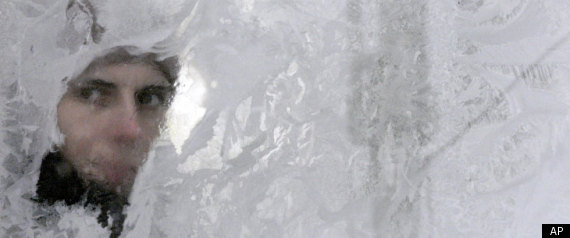Europe: Cold Precautions Taken To Protect Homeless
KIEV, Ukraine — Russia and Ukraine both took extra precautions on Friday to protect homeless people, ordering new facilities and medical care after scores of people have frozen to death on the streets of Europe during a brutal cold snap.
streets of Europe during a brutal cold snap.As the death toll from the past week rose to at least 175 on Friday, Russian Emergencies Minister Sergei Shoigu ordered the creation of facilities nationwide to feed and provide medical assistance to the homeless.
Russia has not reported casualty figures from the cold snap, which has gripped a large swath of the continent from Russia to Serbia and reached as far west as the Netherlands. But Russian Deputy Health Minister Maxim Topilin was quoted by the ITAR-Tass news agency on Friday as saying that at least 64 people died from the cold in all of January.
With tens of thousands of protesters expected on the streets of Moscow on Saturday, doctors advised those taking part in the demonstrations to protect themselves from the cold as their grandmothers used to do: by wearing felt boots and smearing their faces with goose or pig fat.
Protesters also were encouraged to eat a big breakfast, preferably including meat, and refrain from drinking alcohol. While most will be protesting against Vladimir Putin’s government, others will attend a separate pro-Putin rally.
In Ukraine, the hardest hit country, health officials have told hospitals to stop discharging the hundreds of homeless patients after they are treated for hypothermia and frostbite. The goal is to prevent them from dying once they are released into temperatures as low as minus 32 Celsius (minus 26 Fahrenheit).
Authorities also have set up nearly 3,000 heating and food shelters.
Thirty-eight more fatalities were reported from frostbite and hypothermia in Ukraine on Friday, raising the nation’s death toll to 101. Emergency officials have said many of the victims were homeless.
Mykola Blyznyuk of the Health Ministry told the Kiev Post newspaper that many of the victims of hypothermia had broken their legs in falls and spent a long time on the ground in freezing temperatures while waiting for help to arrive.
Of the Ukrainians who have died since the cold weather hit Jan. 27, 64 were found frozen on the streets, 11 died in hospitals and 26 in their homes, emergency officials said.
It was so cold there, that some 1,500 swans, sea gulls and ducks froze to the ice in a small harbor near Ukraine’s Black Sea port of Odessa, forcing emergency workers to use ships to break up the surface and free the birds, officials said.
The weeklong cold snap – Eastern Europe’s worst in decades – is causing power outages, frozen water pipes and the widespread closure of schools, nurseries, airports and bus routes.
Bosnia reported its first deaths due to cold and snow. Five people died Friday in Sarajevo, most of them while shoveling snow, Dr. Tigran Elezovic said, and one person died in the southern city of Mostar, where ambulances could not reach the victim because of snow.
Rome – where Italians are usually spared from cold winter weather – experienced a rare snowfall on Friday, prompting officials to close the Colosseum, the Roman Forum and the Palatine Hill, the former home of Rome’s ancient emperors, to prevent tourists from slipping and falling.
Northern Italy also has been gripped by snow and ice that is disrupting train travel.
Temperatures in the Italian Alps have fallen as low as minus -22 C (minus 7 F).
In the Netherlands, police in the eastern city of Wageningen reported that a homeless man found dead Thursday in a shed died of hypothermia, making him the first confirmed Dutch victim of the cold.
Traffic around the Netherlands was thrown into chaos Friday by snow. Trains ran with long delays and several flights in and out of Schiphol were delayed or canceled.
In Poland, the Interior Ministry recorded eight more deaths on Friday and said two other people died of asphyxiation from carbon monoxide-spewing charcoal heaters.
In Serbia, where six people have died, blizzards gripped Belgrade, the capital, and Novi, the country’s second-largest city, complicating efforts to rescue people trapped in their homes.
Schools throughout the country will shut down next week, as part of emergency measures to deal with weather problems and save energy amid record electricity and gas consumption. The government also allocated fuel from emergency reserves for stranded areas in the Balkan country.
Neighboring Croatia and Montenegro also were hard hit. In Croatia, some highways were closed and waters of the Adriatic Sea froze in some areas. Buses that travel from Zagreb, the capital, toward the coast have been canceled.
In Montenegro, blizzards halted railway traffic, while cars were stranded in heavy snowfall on the roads in the north near the border with Serbia. Part of the capital, Podgorica, and a nearby area were left without electricity. The airport was closed due to heavy snow.
In northern Serbia, hundreds of tons of fish in the Ecka lakes were in danger because the water was icing over. Dozens of people have been working nonstop to break the ice, using hammers and all kinds of tools, and sometimes even falling into the freezing water.
No comments:
Post a Comment